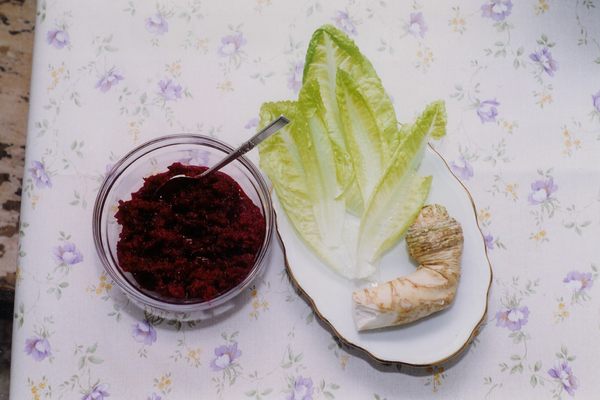When Iraqi Jews fled to Israel, they opened shops serving dishes that reminded them of home. Immigrants dotted the suburbs of Tel Aviv with shawarma and falafel stands, equipped with condiments and spices that reflected the Iraqi palate. Amba is one such contribution. Today, Israelis know and love this spiced, fermented mango topping, which is found across the Middle East. Despite the local love, amba actually originated in India. In fact, it means “mango” in Marathi—the language spoken in the Indian state of Maharashtra.
Cooks prepare homemade amba by salting and jarring green mango slices, then leaving the fruit to ferment for at least five days. The longer the mango sits, the deeper its flavor becomes. Once optimal fermentation is achieved, makers remove the fruit and leave it out to dry in the sun. Finally, they simmer the funky, sun-dried strips with spices such as turmeric and chili. Some cooks opt to add a savory pop of garlic and cumin, while others incorporate tanginess with vinegar or sour salt. Traditional Indian versions use fenugreek and mustard seeds. Once the amba is properly seasoned, it’s re-jarred for later use.
Vendors make the most of amba’s tangy, hot, tropical flavors by pairing it with just about any protein. Whether grilling meat, seafood, or tofu, or even mixing a Greek yogurt dip, amba adds a flavor-punch that complements them all. There’s a reason this versatile condiment has a fanbase that stretches from India to Israel.
Written By
 rachelrummel
rachelrummel
Sources
- food52.com/recipes/17424-sour-sweet-hot-and-salty-amba-mango-condiment
- www.myjewishlearning.com/the-nosher/your-new-favorite-israeli-condiment-amba-a-pickled-mango-sauce/
- www.cardamomandtea.com/blog/amba
- books.google.com/books?id=F8ZBAAAAIAAJ&pg=PA7&dq=amba+mango+maranthi&hl=en&sa=X&ved=0ahUKEwjX9d6YrPfbAhUL84MKHec9A0AQ6AEINjAC#v=onepage&q=amba%20mango%20maranthi&f=false
- books.google.com/books?id=gFK_yx7Ps7cC&pg=PT115&dq=amba+iraqi+jews&hl=en&sa=X&ved=0ahUKEwj-iqvlsffbAhUh9IMKHViKBPoQ6AEIMjAC#v=onepage&q=amba%20iraqi%20jews&f=false
- www.amazon.com/Jerusalem-Cookbook-Yotam-Ottolenghi/dp/1607743949/ref=asap_bc?ie=UTF8
The Atlas Obscura Podcast is Back!













